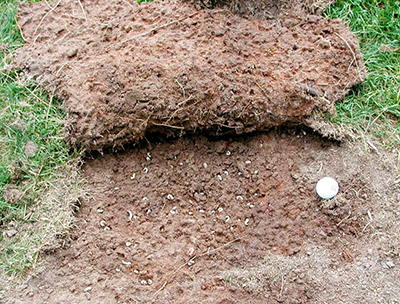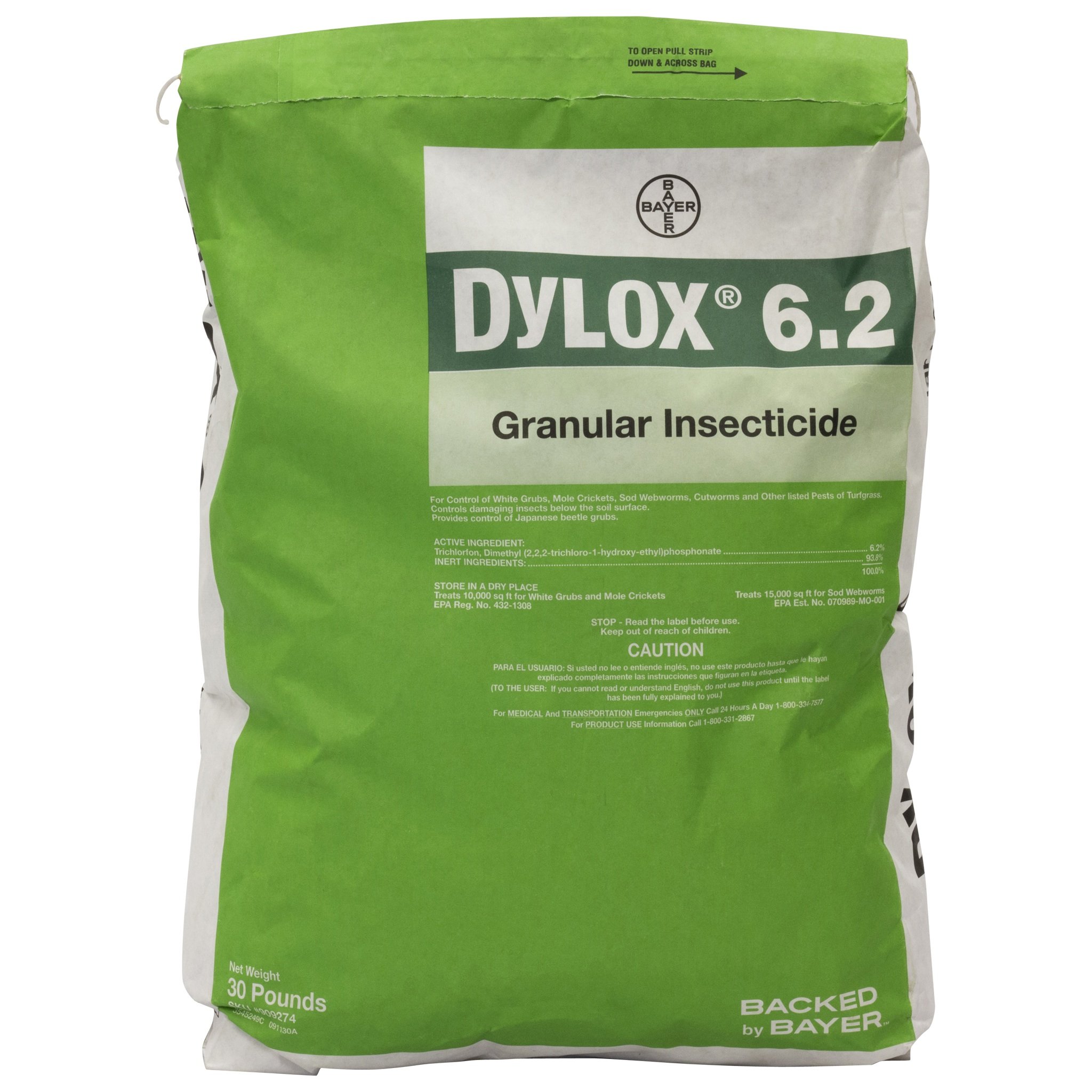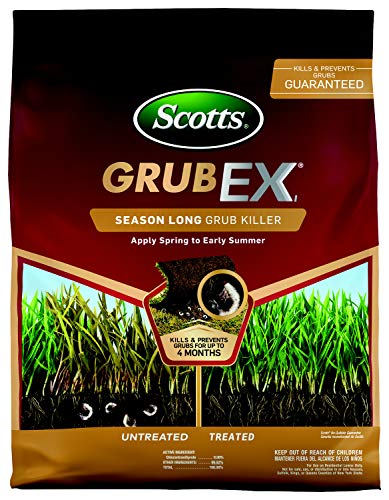Insecticide For White Grubs
Be sure the problem is grubs. Before doing anything, it is important to make sure the problem is grubs. In the last 10 years, the amount of European chafer damage to home lawns in southern Michigan has steadily decreased to the point where it is unusual now to find populations high enough to damage turf. However, as European chafers and Japanese beetles have spread northward, lawns and other low maintenance turf areas in much of the Lower Peninsula north of Lansing and in the eastern half of the Upper Peninsula are seeing more damage. The outbreak phase where turf damage is common may last five to 10 years.
If you see a dead patch, use a shovel to dig up a few Frisbee-size samples of turf around the bare spot to a depth of 2 inches and look for 0.75-inch long, C-shaped white grubs. These are most likely the larvae of European chafers if they are found in lawns without an irrigation system. European chafers can devastate a lawn with little warning because the adult beetles fly at dusk when they emerge in June and early July, and can easily be overlooked because their evening flight to mate and lay eggs occurs after sunset. European chafers are generally found in drier turf and their population levels will fluctuate depending upon how wet or dry the weather was the previous summer.
European chafer grubs may be found in all locations in Michigan’s Lower Peninsula and in much of the Upper Peninsula. Regionally, European chafers are a much bigger problem than they used to be. In 2002, they were only found in New York, Pennsylvania, Massachusetts, Delaware, New Jersey, Connecticut, New Hampshire, Vermont, Maryland, Southern Michigan, and eastern Ohio. Now it has spread throughout Ohio, Michigan (all of the Lower and half of the Upper Peninsula), northern Indiana and into eastern Illinois. It was also reported in Wisconsin in 2013. In Canada, it is a problem in Ontario and Vancouver, so Washington State is on the lookout for it also.
Japanese beetle grubs also feed on turf roots in home lawns, but they are not usually as much of a problem on home lawns as European chafers can be. Japanese beetles and European chafers lay most of their eggs in July, but Japanese beetles continue laying eggs into August. Japanese beetles like to lay their eggs on irrigated turf like golf courses, athletic fields and highly maintained lawns. They can be abundant in non-irrigated home lawns if we receive frequent rain in July, but are scarce in lawns that are very dry in July and early August. We don’t seem to be getting as many calls about lawns damaged by Japanese beetle grubs in the southern half of the Lower Peninsula, south of Lansing, but we are getting more calls from the northern Lower Peninsula as Japanese beetles continue to spread northward. Wisconsin, Minnesota and Iowa have now joined the club of Midwest states with lots of Japanese beetles, and they have been found in isolated locations as far west as Colorado.

The eggs of both species hatch about 10 days after they are laid. The grubs feed from the beginning of August until late October. By the end of October, they are fully grown. The larvae of both species look almost identical. They spend the winter as large grubs (0.75 inches long) some 2-6 inches below the soil surface. When the ground warms up in spring, they resume feeding and can cause damage from the time the grass turns green until they pupate in mid-May. Grub damage may appear in home lawns from mid-September to November or from March to early May. However, for low-maintenance lawns, even if the turf is not killed from grub feeding, the thinned and weakened turf may be prone to weeds and drought stress.
Healthy turf with a few grubs may not need an insecticide. It is important to realize that healthy turf, supported by frequent rain or irrigation, can support a grub population of five or more grubs per square foot with no visible turf damage. In fact, most well-maintained lawns do not have visible damage from grubs. A lawn should be mowed at 3 to 4 inches in height and properly fertilized for maximum root growth. However, if the grub population is high or if there is a history of damage in an area, it may be necessary to consider using an insecticide for grub control. Finding one or two grubs does not indicate you need to apply a grub control product.
Check for the active ingredient in a grub product. I went to several of the local lawn and garden centers in the Lansing, Michigan, area to see what kinds of products are available that specifically claim they will work to control grubs. I found five to nine different products at each store. The profusion of different products can be rather mystifying. The critical issue with any grub control product is the active ingredient. There are many products available, some with the same active ingredients. The active ingredients are usually shown on the bottom right or left of the front of the bag and listed as a percent of composition.
Water the lawn immediately after applying the insecticide. The second major concern is to make sure the insecticide is thoroughly watered into the ground with at least a half-inch of irrigation or rain immediately after the chemical is applied. You can measure how much irrigation is applied by putting out several coffee cups in your lawn and run the irrigation until they fill to a half-inch level above the bottom. Research tests over the last 25 years have clearly shown that watering immediately after application helps to obtain good results. This also moves the chemical off the grass and will make the yard safe for children, pets and wildlife after the yard is dry.
Use the right rate/amount of product. A third concern is the rate at which the insecticide is applied. The label lists the legal rate at which the product can be used. There is little benefit to exceeding this rate, and doing so is also illegal. There are also products for sale that list grubs on the label that do NOT work for grubs. Insecticides used for grubs can be separated into two groups based on how they work: preventive chemicals and curative chemicals.
1) PREVENTIVE insecticides that will prevent grub damage next fall (2020) and following spring (2021)
These products are used to prevent future grub problems, not to control the grubs present in the lawn in the spring. They will not work on grubs found in the lawn from the middle of October through the middle of May. However, when applied in June or July they provide excellent protection against the next generation of grubs. So, if you need to apply the preventive insecticide BEFORE the grubs are there, how do you know if you need to use an insecticide or not? If you confirmed grub damage the previous fall or spring, meaning you found lots of grubs, then you may want to use a preventive insecticide for one or two years to build a more dense turf that will be tolerant of grubs. If you have treated for several years and you do not see evidence of grubs in your lawn or in the neighbor’s lawn, it may be time to stop treating. There is an erroneous philosophy being perpetuated that because we have European chafers and Japanese beetles in the area, it is necessary to treat every year or your lawn will be damaged by grubs. This is not true.
Preventive products are the most effective. Products containing imidacloprid, thiamethoxam, clothianidin or chlorantraniloprole will not control grubs in the spring. They are preventive products that work very well on newly hatched grubs present in July, but do not work well for large grubs found from September to May. There are different recommended timings for application depending on the active ingredient. Although the bag often says apply anytime from May to Aug. 15, it is highly recommended that products containing imidacloprid, thiamethoxam, clothianidin be applied and irrigated into the soil in June or July. If applied in early spring, the pesticide may move through the soil or partially degrade by the time the grubs hatch in late July. If applied too late, preventative products may not be effective as they work best on small grubs.
Preventive products containing imidacloprid, thiamethoxam or clothianidin will consistently reduce 75-100% of the grubs if they are applied in June or July and if they are watered-in with 0.5 inches of irrigation immediately after application. Lawn sprinklers can be used if you do not have an irrigation system.
There is another active ingredient in some insecticides called chlorantraniliprole that will also work in preventing grub problems, but it is less water soluble than the other preventive compounds mentioned above, so it can be applied any time after the grass turns green in the spring. Chlorantraniliprole can be applied as early as April and up to mid-July. This chemical consistently reduced grub numbers by about 65-80% and research has shown that applications made before June are more efficacious than June or July application.
Some of these products come in a granular formulation that is applied with a fertilizer spreader or some products are designed to be mixed with water and sprayed. Also, in the last two years several products have become available in an attach-to-hose bottle and are automatically mixed with water when applied.
Protecting bees and other pollinators. If you are applying a product containing clothianidin, thiamethoxam or imidacloprid, the lawn should be mowed prior to the application so that no weeds are flowering in the lawn when the insecticide is applied. These active ingredients can be toxic to bees if the bees visit flowers that were recently sprayed. Mowing prior to making the application will avoid this problem by removing the flowers. Weeds that flower again after mowing are much safer than weed flowers that were sprayed directly with insecticide, but some of the insecticide is absorbed by the roots and will move into the pollen and nectar. More research is needed on this, but it could cause problems for native bees or have long-term health effects on honey bees or bumble bees. If there is nothing flowering in the lawn, there is nothing in it that would attract bees.
In addition, grub control products that contain the active ingredient chlorantraniliprole are safe for bees, even when weed flowers are sprayed. Finally, avoid spray drift or granular spreader drift to flower beds when applying thiamethoxam, imidacloprid, clothianidin or any insecticide for grubs other than chlorantraniliprole
2) CURATIVE insecticides
There are two chemicals, carbaryl and trichlorfon, that are considered curative treatments. They are short-lived compounds that kill all life stages of grubs. These two insecticides are the only options if high numbers of grubs are found in the fall and in spring before early May. Our research indicates they will kill 20-80% of grubs when applied in September or 20-55% when applied in late October. They are not as effective as the preventive compounds in reducing grub numbers.
Consider carefully whether it would be best to wait and apply a preventive later. If the need should arise to use a curative compound, make sure to keep the infested lawn watered and fertilized and treat the area again with a preventive application the next summer or the problem will likely reoccur in the fall or the following spring. Current research also shows that watering with 0.5 inches of irrigation immediately after the application is essential to get effective results from these insecticides.
Our research has indicated that carbaryl has been a little more effective on European chafer grubs than trichlorfon. Both compounds work equally well on Japanese beetle grubs. It will take 10-14 days for the grubs to begin dying after the insecticide is applied. One trichlorfon product has “24 Hour Grub Control” in its name and would seem to indicate that it will kill grubs in 24 hours. However, even trichlorfon should not be evaluated for at least five days after application (assuming it rains or irrigation was applied), and carbaryl may need three to four weeks to be effective. Do not apply any curative compounds in the spring after May 15 as grubs stop feeding in late May as they prepare to pupate. As with the preventive products, lawns should be mowed immediately before applying carbaryl or trichlorfon to protect bees.
3) Insecticides that DO NOT work on grubs
Do not use products containing ONLY lambda-cyhalothrin, gamma-cyhalothrin, bifenthrin, deltamethrin, cyfluthrin or permethrin for grub control. Products containing only these ingredients will not work for grub control because the active ingredient binds with organic material and will not move down to where the grubs are feeding. These products work well for above-ground feeding insects that live on the grass leaves or soil surface, but not for insects that feed on the roots. At one garden center a clerk showed us two products, one containing only permethrin and one containing only bifenthrin, when we asked for products to control grubs. Neither of the products listed grubs on the label printed on the bag and neither of the products would have controlled grubs.
There are several products on the market that contain a combination of one of the preventive compounds and one of the above listed insecticides that “do not work on grubs.” The preventive ingredient will make it an effective choice for grub control.
There is a widely sold trade name called Triazicide from Spectrum that lists grubs on the label and states it will control insects above or below ground and has a picture of a grub on the front of the bag. It contains only lambda-cyhalothrin or gamma-cyhalothrin. Triazicide will not control grubs. Carefully check the label for ingredients. There was a product available in years past from Spectrum that contained imidacloprid, but I did not see any in my visits the last two years (2016 and 2017).
Insecticide For White Grubs
White grubs are a common problem for lawns and gardens, and the best way to get rid of them is with an insecticide. But what is an insecticide? It’s a chemical that kills insects. The first step in getting rid of white grubs is to find out if you have any in your lawn. You can do this by spotting them yourself or by hiring someone else to do it.
The next step is to find out which insecticide will work best on your lawn. There are many different types of insecticides available, so it’s important to choose one that will effectively kill white grubs without harming other plants or animals in your yard. In addition, some insecticides are designed specifically for killing off other insects while others target only white grubs.
Once you’ve chosen an appropriate insecticide based on its intended purpose, you should apply it according to manufacturer instructions. This may include watering down the product before application or mixing it with water before applying it directly onto soil surface areas where white grubs have been spotted previously during previous seasons (no more than once per week).
Insecticides will typically last about two weeks after application depending on conditions such as weather patterns like precipitation levels (rainfall amounts)
List Of Insecticide For White Grubs
- Trichlorfon 6.2%
- Dylox 6.2 is for use in and around landscape flowers, shrubs, trees, landscape and recreational turf, golf courses, and residential turf.
- Dylox 6.2 Kills and Controls Armyworms Cutworms Webworms Cranberry Girdlers Bluegrass Weevils Billbug Larvae Mole Crickets Chinch Bugs White Grubs
Additional Info :
| Item Dimensions | |
| Height | 11 Inches |
| Width | 9 Inches |
| Length | 16 Inches |
| Weight | 30.55 Pounds |
- Broad-Spectrum control of other soil and surface feeding insects.
- Longest residual for consistent grub control.
- Does not require immediate watering in.
- Great for both preventative and curative white grub control.
Additional Info :
| Item Dimensions | |
| Weight | 30 Pounds |
- Imidacloprid 0.5%
- Merit is for use in and around Turfgrasses, Trees, Shrubs, Evergreens, Flowers, Foliage Plants, Ground Covers.
- Applications of MERIT 0.5 G Insecticide cannot exceed a total of 80 lb (0.4 lb of active ingredient) per acre per year.
Additional Info :
| Item Dimensions | |
| Height | 13 Inches |
| Width | 6 Inches |
| Length | 11.9 Inches |
| Weight | 30.1 Pounds |
- One application in the spring or early summer kills and prevents grubs and armyworms for 4 months
- Helps prevent root damage caused by insects for a stronger lawn
- Prevents turf damage by killing grubs when they are young
- Kills 25% more grub types vs. original GrubEx
- Scotts products are designed to work with Scotts spreaders
Additional Info :
| Item Dimensions | |
| Height | 3.5 Inches |
| Width | 12 Inches |
| Length | 16 Inches |
| Weight | 14.7 Pounds |
- 24-HOUR GRUB KILLER: Delivers overnight results by killing grubs in 24 hours
- PLUS INSECT KILLER: Also kills Ants, Ticks, Billbugs, Chinch Bugs, Crickets, Cutworms, Earwigs, Grasshoppers, and more
- PREVENTS LAWN DAMAGE: Use at the first sign of grubs to stop further lawn damage
- COVERAGE AREA: Treats up to 5,000 square feet
- RESTRICTIONS: Not for sale in CA & ME
Additional Info :
| Color | Ready-to-Spread Granules, Standard Bag |
| Item Dimensions | |
| Height | 1 Inches |
| Width | 12 Inches |
| Length | 19 Inches |
| Release Date | 2011-05-31T00:00:01Z |





